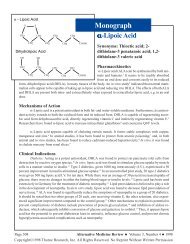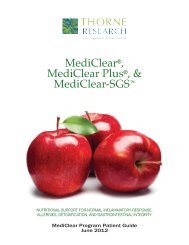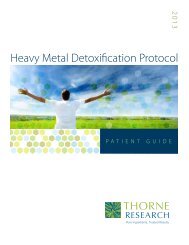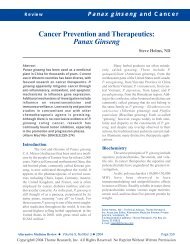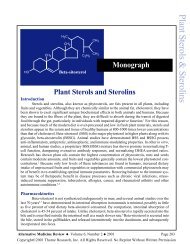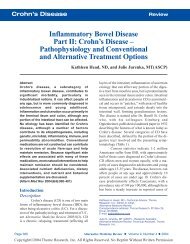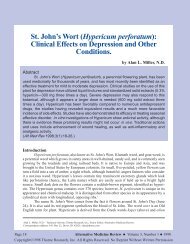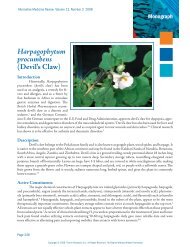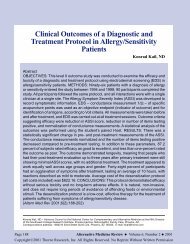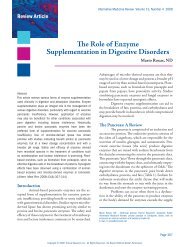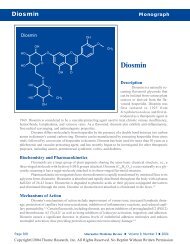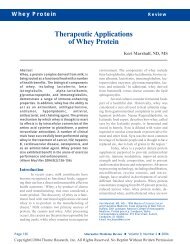Inulin-Type Prebiotics â A Review: Part 1 - Alternative Medicine ...
Inulin-Type Prebiotics â A Review: Part 1 - Alternative Medicine ...
Inulin-Type Prebiotics â A Review: Part 1 - Alternative Medicine ...
You also want an ePaper? Increase the reach of your titles
YUMPU automatically turns print PDFs into web optimized ePapers that Google loves.
<strong>Review</strong> Article<br />
<strong>Alternative</strong> <strong>Medicine</strong> <strong>Review</strong> Volume 13, Number 4 2008<br />
a dose-effect be established These questions have yet to<br />
be definitely answered.<br />
In terms of addressing the first question, while<br />
independent studies have been conducted on FOS,<br />
oligo fructose, inulin, inulin HP, oligofructose-enriched<br />
inulin, and oligofructose-enriched inulin HP for their<br />
ability to influence gut flora, no comparative studies<br />
have been conducted. In the studies that investigated<br />
individual inulin-type prebiotics, the dose, study population,<br />
length of supplementation, and time intervals for<br />
microbiological analysis have varied. So, not surprisingly,<br />
reported results are not consistent. Despite these<br />
limitations and the need for more comparative research,<br />
Roberfroid reports that the prebiotic activity of different<br />
inulin-type prebiotics appear to be similar. 2<br />
Prebiotic Activity of FOS<br />
Studies of FOS consistently report bifidogenic<br />
activity. Reported effects on other organisms are<br />
inconsistent, with some reporting no change, others a<br />
decrease, and others an increase in anaerobes. In the one<br />
study that continued to analyze stool samples following<br />
discontinuation of FOS, the potential for a rebound increase<br />
in undesirable organisms after cessation of FOS<br />
was suggested. 13<br />
Buddington et al gave 4 g FOS daily to 12<br />
healthy subjects between days 7 and 32 of a 42-day<br />
controlled diet period. FOS supplementation increased<br />
total anaerobes and Bifidobacteria as assessed by stool<br />
culture. The species of Enterobacteriaceae and Bifidobacteria<br />
were not distinguished. 37<br />
Gibson et al reported that FOS increased<br />
the proportion of Bifidobacteria from 6-22 percent<br />
(assessed by stool cultures) in healthy adults during<br />
two weeks of supplementing 15 g daily in three divided<br />
doses. Significant decreases in Bacteroides, Clostridia,<br />
and Fusobacteria were also reported after two weeks of<br />
supplementation. 38<br />
Bouhnik et al gave FOS or placebo to 20<br />
healthy volunteers who were observed for three consecutive<br />
12-day periods (baseline, supplementation, and<br />
follow-up). During the 12-day ingestion period, subjects<br />
received 12.5 g/day FOS or sucrose as the placebo<br />
in three divided doses. FOS ingestion increased fecal<br />
Bifidobacteria counts and had no significant effect on<br />
fecal total anaerobes as assessed by stool culture. 33<br />
Bouhnik et al also conducted a longer-term<br />
study of FOS in 12 elderly volunteers (mean age 69)<br />
maintained on a controlled diet and given 8 g FOS daily<br />
in two divided doses. After four weeks, fecal Bifidobacteria<br />
counts were significantly increased compared to the<br />
pre-intervention observation period as assessed by stool<br />
culture. Four weeks following discontinuation of FOS<br />
supplementation, fecal Bifidobacteria counts returned<br />
to approximately initial levels, indicating supplementation<br />
had no lasting bifidogenic effect. Total anaerobe<br />
counts did not change with FOS supplementation, but<br />
were statistically decreased following discontinuation<br />
of FOS. No significant differences in fecal Clostridium<br />
counts were observed during FOS supplementation;<br />
however, a statistically significant rebound increase was<br />
observed during the follow-up period compared to the<br />
basal and active FOS supplementation periods. No statistically<br />
significant differences in fecal Enterobacteriaceae<br />
counts were observed during FOS supplementation<br />
or after discontinuation. 13<br />
Prebiotic Activity of Oligofructose<br />
Studies that supplemented oligofructose consistently<br />
report bifidogenic activity during the period of<br />
active supplementation; however, findings with other<br />
organisms such as Clostridia have been inconsistent.<br />
In a double-blind study, Kapiki et al fed 56<br />
preterm infants standard infant formulas with addition<br />
of either oligofructose or a placebo (maltodextrin) for<br />
14 days within the first two weeks after birth. Oligofructose<br />
increased the average number of stool Bifidobacteria<br />
and the proportion of infants colonized with<br />
Bifidobacteria. Stool culture yielded a higher number of<br />
Bacteroides and a reduction in numbers of Escherichia<br />
coli and Enterococci in the oligofructose group. 47<br />
In a randomized, crossover study, Euler et al<br />
gave formula-fed, full-term infants (ages 2-6 weeks) a<br />
cow’s milk formula with or without oligofructose; washout<br />
weeks preceded and followed a week of oligofructose-supplemented<br />
formula feeding. Culture-based microbial<br />
assessment was used. A statistically significant<br />
increase in Bifidobacteria was observed following seven<br />
days of oligofructose feeding; however, it was not maintained<br />
after discontinuation. No statistically significant<br />
changes in Lactobacilli occurred with oligofructose<br />
supplementation. Clostridium difficile counts increased<br />
Page 324<br />
Copyright © 2008 Thorne Research, Inc. All Rights Reserved. No Reprint Without Written Permission.



